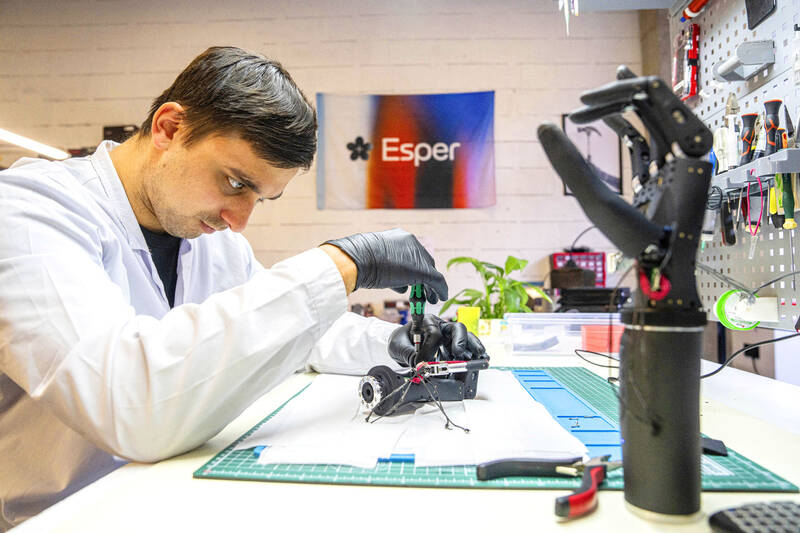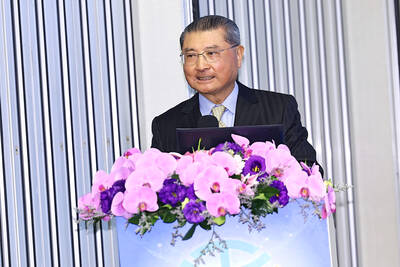When Alexis Cholas lost his right arm as a volunteer combat medic near the front lines in eastern Ukraine, his civilian career as a surgeon was over. Thanks to a new bionic arm, he was able to continue working in healthcare and is now a rehab specialist helping other amputees.
The 26-year-old is delighted with his sleek black robotic arm — he described it as “love at first sight” — and realizes how lucky he was to get one.
“There are fewer [bionic] arms available than lost ones,” Cholas said.

Photo: AP
Russia’s invasion of Ukraine has created a massive need for prosthetic limbs. An estimated 20,000 Ukrainians have had amputations since the war started in February last year, many of them soldiers who lost arms or legs due to blast wounds.
Only a small number was able to receive bionic prostheses, which are more advanced and can provide greater mobility than the traditional prosthetic limbs.
They are also far more costly than conventional prostheses.
Bionic artificial limbs typically pick up electrical signals from the muscles that remain above the amputation site, thanks to something called myoelectric technology, to carry out an intended motion.
Cholas’ bionic arm was made by Esper Bionics. Before last year, the Ukrainian start-up primarily targeted the US market, but due to the sharp rise in demand for prosthetic limbs caused by the war, Esper now distributes 70 percent of its products at home.
The company’s production hub in the capital, Kyiv, is working at full capacity, with more than 30 workers producing about dozen bionic hands a month.
In one corner of the factory, a small group of engineers huddle as they program, assemble and test the elegant bionic arms — known as Esper Hand. Each finger’s movement on the robotic hand is accompanied by a soft whirring sound, assuring the engineers of its smooth operation.
Bohdan Diorditsa, head of strategic relations at the company, said that despite ramping up production, Esper Bionics is struggling to keep up with demand, with almost 120 people on the waitlist.
In Ukraine, the company said it provides the bionic prostheses at zero profit for about US$7,000 a piece, just enough to cover production costs.
In the US, the Esper Hand sells for more than US$20,000.
“We do not consider Ukraine as a market, but rather as an opportunity to help,” Diorditsa said.
Compared to a conventional prosthesis, which is designed to replicate simple basic functions of a missing arm or leg, a bionic one offers the capability to restore fine motor skills.
“Everyone wants them,” said Anton Haidash, a prosthetist at Unbroken, a municipal center in Lviv that focuses on rehabilitation of civilians and soldiers affected by the war.
The center has helped provide prosthetic limbs to about 250 people so far, including about 20 bionic arms.
The difference in cost is significant. While bionic limbs can cost up to US$50,000, conventional artificial limbs are priced at US$800 to US$2,700, Haidash said.
Ukrainians can get the regular artificial limbs free of charge through the public health care system. To get a bionic prosthesis, they normally need additional funding from charities or rehabilitation centers such as Unbroken, which depend on donations.
While patients can make the final decision about the type of prostheses they want, a variety of factors, including the nature of the injury and the person’s occupation, also play a role.
Unbroken purchases bionic prostheses from German and Icelandic companies as well as Esper Bionics, whose notable advantage is having a manufacturing and a service center in Ukraine. This means people do not need to travel abroad when a repair or resizing is required.
Another outstanding characteristic of the Esper Hand, which is powered by artificial intelligence (AI), is its ability to adapt over time, learning the user’s unique interactions with the hand.
After getting outfitted with his bionic arm, Cholas went back to volunteering as a combat medic on the front lines, while in his day job in Kyiv he works as a rehabilitation specialist in a public hospital. Most of his patients are members of the military or civilians who, like him, have lost limbs.
He said that their shared experience helps him quickly develop a rapport with his patients.
“I now know a lot not only from textbooks, but also from my own experience,” he said.
Cholas speaks to his patients encouragingly as he examines their injuries. His movements with the bionic hand are natural and fluid. He effortlessly removes a bandage and dresses a patient’s wounds without the assistance of nurses.
The bionic prosthesis allows him to perform even delicate movements, such as picking up a grape without crushing it, he said.
“I feel uncomfortable when I’m without the prosthesis,” he said. “But when I have the bionic arm on, I feel comfortable. It’s like a part of you.”

When an apartment comes up for rent in Germany’s big cities, hundreds of prospective tenants often queue down the street to view it, but the acute shortage of affordable housing is getting scant attention ahead of today’s snap general election. “Housing is one of the main problems for people, but nobody talks about it, nobody takes it seriously,” said Andreas Ibel, president of Build Europe, an association representing housing developers. Migration and the sluggish economy top the list of voters’ concerns, but analysts say housing policy fails to break through as returns on investment take time to register, making the

‘SILVER LINING’: Although the news caused TSMC to fall on the local market, an analyst said that as tariffs are not set to go into effect until April, there is still time for negotiations US President Donald Trump on Tuesday said that he would likely impose tariffs on semiconductor, automobile and pharmaceutical imports of about 25 percent, with an announcement coming as soon as April 2 in a move that would represent a dramatic widening of the US leader’s trade war. “I probably will tell you that on April 2, but it’ll be in the neighborhood of 25 percent,” Trump told reporters at his Mar-a-Lago club when asked about his plan for auto tariffs. Asked about similar levies on pharmaceutical drugs and semiconductors, the president said that “it’ll be 25 percent and higher, and it’ll

CHIP BOOM: Revenue for the semiconductor industry is set to reach US$1 trillion by 2032, opening up opportunities for the chip pacakging and testing company, it said ASE Technology Holding Co (日月光投控), the world’s largest provider of outsourced semiconductor assembly and test (OSAT) services, yesterday launched a new advanced manufacturing facility in Penang, Malaysia, aiming to meet growing demand for emerging technologies such as generative artificial intelligence (AI) applications. The US$300 million facility is a critical step in expanding ASE’s global footprint, offering an alternative for customers from the US, Europe, Japan, South Korea and China to assemble and test chips outside of Taiwan amid efforts to diversify supply chains. The plant, the company’s fifth in Malaysia, is part of a strategic expansion plan that would more than triple

Taiwanese artificial intelligence (AI) server makers are expected to make major investments in Texas in May after US President Donald Trump’s first 100 days in office and amid his rising tariff threats, Taiwan Electrical and Electronic Manufacturers’ Association (TEEMA, 台灣電子電機公會) chairman Richard Lee (李詩欽) said yesterday. The association led a delegation of seven AI server manufacturers to Washington, as well as the US states of California, Texas and New Mexico, to discuss land and tax issues, as Taiwanese firms speed up their production plans in the US with many of them seeing Texas as their top option for investment, Lee said. The